- Home
- Max Brooks
The Zombie Survival Guide: Complete Protection From the Living Dead
The Zombie Survival Guide: Complete Protection From the Living Dead Read online
The
ZOMBIE
Survival Guide
Complete Protection from the Living Dead
Max Brooks
Illustrations by Max Werner
CONTENTS
Title Page
Dedication
Introduction
THE UNDEAD: MYTHS AND REALITIES
Solanum: The Virus
Source . . . Symptoms . . . Transference . . . Cross-Species Infection . . . Treatment . . . Reanimating the Already Deceased
Zombie Attributes
Physical Abilities . . . Behavioral Patterns
The Voodoo Zombie
The Hollywood Zombie
Outbreaks
Class 1 . . . Class 2 . . . Class 3 . . . Class 4
Detection
WEAPONS AND COMBAT TECHNIQUES
GENERAL RULES
Obey the Law! . . . Train Constantly . . . Care for Your Tools . . . Beware Display Items . . . Develop the First Weapon
Close Combat
Bludgeons . . . Edged Weapons . . . Miscellaneous Hand Weapons . . . Power Tools
Slings and Arrows
The Sling . . . The Slingshot . . . The Blowgun . . . Shuriken . . . Throwing Knives . . . The Long or Compact Bow . . . The Crossbow . . . The Hand Bow
Firearms
The Heavy Machine Gun . . . The Submachine Gun . . . The Assault Rifle . . . The Bolt-/Lever-Action Rifle . . . The Semiautomatic Rifle . . . The Shotgun . . . The Pistol . . . ..22-Caliber Rimfire Weapons . . . Accessories
Explosives
Fire
Molotov Cocktails . . . Dousing . . . The Blowtorch . . . The Flamethrower
Other Weapons
Acid . . . Poison . . . Biological Warfare . . . Zoological Warfare . . . Electrocution . . . Radiation . . . Genetic Warfare . . . Nanotherapy
Armor
Plate Mail . . . Chain Mail . . . The Shark Suit . . . Helmets . . . Bulletproof Vests . . . Kevlar Covers . . . Tight Clothes and Short Hair
ON THE DEFENSE
The Private Residence (Defending Your Home)
Preparation Part I: The Home . . . Preparation Part II: Supplies . . . Surviving an Attack . . . Immediate Defense
Public Spaces
Office Buildings . . . Schools . . . Hospitals . . . Police Stations . . . Retail Stores . . . Supermarkets . . . Shopping Malls . . . Churches . . . Warehouses . . . Piers and Docks . . . Shipyards . . . Banks . . . Cemeteries . . . Capitols and City Halls
GENERAL RULES
The Fortress
Military Complexes . . . Prisons . . . Offshore Oil Rigs
ON THE RUN
GENERAL RULES
One Goal . . . Establish a Destination . . . Gather Intelligence and Plan Your Journey . . . Get in Shape . . . Avoid Large Groups . . . Train Your Group . . . Remain Mobile . . . Remain Invisible . . . Look and Listen . . . Sleep! . . . Refrain from Overt Signals . . . Avoid Urban Areas
Equipment
Vehicles
The Sedan . . . The SUV . . . The Truck . . . The Bus . . . The Armored Car . . . The Motorcycle . . . Additional Motor-Vehicle Equipment . . . Alternate Road Transportation
Terrain Types
Forest (Temperate/Tropical) . . . Plains . . . Fields . . . Hills . . . Swamp . . . Tundra . . . Desert . . . Urban
Alternate Means of Transportation
By Air . . . By Water
GENERAL RULES
Know Your Waterway . . . Stay in Deep Water . . . Don’t Skimp on Supplies . . . Watch Your Anchor Line!
ON THE ATTACK
GENERAL RULES
Collective Response . . . Keep Discipline . . . Be Alert . . . Use Guides . . . Have a Base, Have Support . . . Use Daylight . . . Plan Your Escape . . . Let Them Come to You . . . Knock! . . . Be Thorough . . . Maintain Communication . . . Kill and Listen . . . Dispose of All Bodies . . . Incendiary Control . . . Never Go Off Alone!
Weapons and Gear
Transportation
Terrain Types
Forest . . . Plains . . . Fields . . . Tundra . . . Hills . . . Desert . . . Urban . . . Jungle . . . Swamp
Strategies
Lure and Destroy . . . The Barricade . . . The Tower . . . Mobile Tower . . . The Cage . . . The Tank . . . The Stampede . . . Motorized Sweep . . . Airborne Sweep . . . The Firestorm . . . Underwater Battles
LIVING IN AN UNDEAD WORLD
The Undead World
Starting Over
GENERAL RULES
Assemble a Group . . . Study, Study, Study! . . . Wean Yourself Off Luxury Items . . . Remain Vigilant . . . To the Ends of the Earth! . . . Know Your Location . . . Become an Expert . . . Plan Your Route . . . Plan B-C-D-E! . . . List Your Gear, Be Ready to Shop . . . Construct Defenses . . . Plan an Escape Route . . . Be on Guard . . . Remain Concealed . . . Remain Isolated
Terrain Types
Desert . . . Mountains . . . Jungle . . . Temperate Forests . . . Tundra . . . Polar . . . Islands . . . Living by Sea
Duration
Then What?
RECORDED ATTACKS
60,000 B.C., Katanda, Central Africa
3000 B.C., Hieraconpolis, Egypt
500 B.C., Africa
329 B.C., Afghanistan
212 B.C., China
121 A.D., Fanum Cocidi, Caledonia (Scotland)
140–41 A.D., Thamugadi, Numidia (Algeria)
156 A.D., Castra Regina, Germania (Southern Germany)
177 A.D., Nameless Settlement Near Tolosa, Aquitania (SW France)
700s A.D., Frisia (Northern Holland)
850 A.D., Unknown Province in Saxony (Northern Germany)
1073 A.D., Jerusalem
1253 A.D., Fiskurhofn, Greenland
1281 A.D., China
1523 A.D., Oaxaca, Mexico
1554 A.D., South America
1579 A.D., The Central Pacific
1583 A.D., Siberia
1587 A.D., Roanoke Island, North Carolina
1611 A.D., Edo, Japan
1690 A.D., The Southern Atlantic
1762 A.D., Castries, St. Lucia, the Caribbean
1807 A.D., Paris, France
1824 A.D., Southern Africa
1839 A.D., East Africa
1848 A.D., Owl Creek Mountains, Wyoming
1852 A.D., Chiapas, Mexico
1867 A.D., The Indian Ocean
1882 A.D., Piedmont, Oregon
1888 A.D., Hayward, Washington
1893 A.D., Fort Louis Philippe, French North Africa
1901 A.D., Lu Shan, Formosa
1905 A.D., Tabora, Tanganyika, German East Africa
1911 A.D., Vitre, Louisiana
1913 A.D., Paramaribo, Surinam
1923 A.D., Colombo, Ceylon
1942 A.D., The Central Pacific
1942–45 A.D., Harbin, Japanese Puppet State of Manchukuo (Manchuria)
1943 A.D., French North Africa
1947 A.D., Jarvie, British Columbia
1954 A.D., Than Hoa, French Indochina
1957 A.D., Mombasa, Kenya
1960 A.D., Byelgoransk, Soviet Union
1962 A.D., Unidentified Town, Nevada
1968 A.D., Eastern Laos
1971 A.D., Nong’ona Valley, Rwanda
1975 A.D., Al-Marq, Egypt
1979 A.D., Sperry, Alabama
Oct. 1980 A.D., Maricela, Brazil
Dec. 1980 A.D., Juruti, Brazil
1984 A.D., Cabrio, Arizona
1987 A.D., Khotan, China
Dec. 1992 A.D., Joshua Tree National Monument, California
Jan. 1993 A.D., Downtown Los Angeles, California
Feb. 1993 A.D., East Los Angeles, California
Mar. 1994 A.D., San Pedro, California
Apr. 1994 A.D., Santa Monica Bay, California
1996 A.D., The Line of Control, Srinagar, India
1998 A.D., Zabrovst, Siberia
2001 A.D., Sidi-Moussa, Morocco
2002 A.D., St. Thomas, U.S. Virgin Islands
Appendix: Outbreak Journal
Endnotes
Acknowledgments
About the Author
Copyright
For Mom and Dad.
And for Michelle,
who makes life
worth fighting for.
INTRODUCTION
The dead walk among us. Zombies, ghouls—no matter what their label—these somnambulists are the greatest threat to humanity, other than humanity itself. To call them predators and us prey would be inaccurate. They are a plague, and the human race their host. The lucky victims are devoured, their bones scraped clean, their flesh consumed. Those not so fortunate join the ranks of their attackers, transformed into putrid, carnivorous monsters. Conventional warfare is useless against these creatures, as is conventional thought. The science of ending life, developed and perfected since the beginning of our existence, cannot protect us from an enemy that has no “life” to end. Does this mean the living dead are invincible? No. Can these creatures be stopped? Yes. Ignorance is the undead’s strongest ally, knowledge their deadliest enemy. That is why this book was written: to provide the knowledge necessary for survival against these subhuman beasts.
Survival is the key word to remember—not victory, not conquest, just survival. This book will not teach you to become a professional zombie hunter. Anyone wishing to devote their life to such a profession must seek training elsewhere. This book was not written for the police, military, or any government agency. These organizations, if they choose to recognize and prepare for the threat, will have access to resources far beyond those of private citizens. It is for them that this survival guide was written—private citizens, people with limited time and resources who nonetheless have refused to be victimized.
Naturally, many other skills—wilderness survival, leadership, even basic first aid—will be necessary in any encounter with the living dead. These were not included in this work, as they can be found in conventional texts. Common sense will dictate what else should be studied to complement this manual. Subsequently, all subjects not directly related to the living dead have been omitted.
From this book, you will learn to recognize your enemy, to choose the right weapons, about killing techniques, and about preparation and improvisation when on the defense, on the run, or on the attack. It will also discuss the possibility of a doomsday scenario, in which the living dead have replaced humanity as the planet’s dominant species.
Do not discount any section of this book as hypothetical drama. Every ounce of knowledge was accumulated by hard-won research and experience. Historical data, laboratory experiments, field research, and eyewitness accounts (including those of the author) have all served to create this work. Even the doomsday scenario is an extrapolation of true-life events. Many actual occurrences are chronicled in the chapter of recorded outbreaks. Studying them will prove that every lesson in this book is rooted in historical fact.
That said, knowledge is only part of the fight for survival. The rest must come from you. Personal choice, the will to live, must be paramount when the dead begin to rise. Without it, nothing will protect you. On the last page of this book, ask yourself one question: What will you do—end your existence in passive acceptance, or stand up and shout, “I will not be their victim! I will survive!” The choice is yours.
THE UNDEAD: MYTHS AND REALITIES
He comes from the grave, his body a home of worms and filth. No life in his eyes, no warmth of his skin, no beating of his breast. His soul, as empty and dark as the night sky. He laughs at the blade, spits at the arrow, for they will not harm his flesh. For eternity, he will walk the earth, smelling the sweet blood of the living, feasting upon the bones of the damned. Beware, for he is the living dead.
—OBSCURE HINDU TEXT, CIRCA 1000 B.C.E.
ZOM-BIE: (Zom¢be) n. also ZOM-BIES pl. 1. An animated corpse that feeds on living human flesh. 2. A voodoo spell that raises the dead. 3. A Voodoo snake god. 4. One who moves or acts in a daze “like a zombie.” [a word of West African origin]
What is a zombie? How are they created? What are their strengths and weaknesses? What are their needs, their desires? Why are they hostile to humanity? Before discussing any survival techniques, you must first learn what you are trying to survive.
We must begin by separating fact from fiction. The walking dead are neither a work of “black magic” nor any other supernatural force. Their origin stems from a virus known as Solanum, a Latin word used by Jan Vanderhaven, who first “discovered” the disease.
SOLANUM: THE VIRUS
Solanum works by traveling through the bloodstream, from the initial point of entry to the brain. Through means not yet fully understood, the virus uses the cells of the frontal lobe for replication, destroying them in the process. During this period, all bodily functions cease. By stopping the heart, the infected subject is rendered “dead.” The brain, however, remains alive but dormant, while the virus mutates its cells into a completely new organ. The most critical trait of this new organ is its independence from oxygen. By removing the need for this all-important resource, the undead brain can utilize, but is in no way dependent upon, the complex support mechanism of the human body. Once mutation is complete, this new organ reanimates the body into a form that bears little resemblance (physiologically speaking) to the original corpse. Some bodily functions remain constant, others operate in a modified capacity, and the remainder shut down completely. This new organism is a zombie, a member of the living dead.
1. SOURCE
Unfortunately, extensive research has yet to find an isolated example of Solanum in nature. Water, air, and soil in all ecosystems, from all parts of the world, have turned up negative, as have their accompanying flora and fauna. At the time of this writing, the search continues.
2. SYMPTOMS
The timetable below outlines the process of an infected human (give or take several hours, depending on the individual).
Hour 1: Pain and discoloration (brown-purple) of the infected area. Immediate clotting of the wound (provided the infection came from a wound).
Hour 5: Fever (99–103 degrees F), chills, slight dementia, vomiting, acute pain in the joints.
Hour 8: Numbing of extremities and infected area, increased fever (103–106 degrees F), increased dementia, loss of muscular coordination.
Hour 11: Paralysis in the lower body, overall numbness, slowed heart rate.
Hour 16: Coma.
Hour 20: Heart stoppage. Zero brain activity.
Hour 23: Reanimation.
3. TRANSFERENCE
Solanum is 100 percent communicable and 100 percent fatal. Fortunately for the human race, the virus is neither waterborne nor airborne. Humans have never been known to contract the virus from elements in nature. Infection can occur only through direct fluidic contact. A zombie bite, although by far the most recognizable means of transference, is by no means the only one. Humans have been infected by brushing their open wounds against those of a zombie or by being splattered by its remains after an explosion. Ingestion of infected flesh (provided the person has no open mouth sores), however, results in permanent death rather than infection. Infected flesh has proven to be highly toxic.
No information—historical, experimental, or otherwise—has surfaced regarding the results of sexual relations with an undead specimen, but as previously noted, the nature of Solanum suggests a high danger of infection. Warning against such an act would be useless, as the only people deranged enough to try would be unconcerned for their own safety. Many have argued that, given the congealed nature of undead bodily fluids, the chances of infection from a non-bite c
ontact should be low. However, it must be remembered that even one organism is enough to begin the cycle.
4. CROSS-SPECIES INFECTION
Solanum is fatal to all living creatures, regardless of size, species, or ecosystem. Reanimation, however, takes place only in humans. Studies have shown that Solanum infecting a non-human brain will die within hours of the death of its host, making the carcass safe to handle. Infected animals expire before the virus can replicate throughout their bodies. Infection from insect bites such as from mosquitoes can also be discounted. Experiments have proven that all parasitic insects can sense and will reject an infected host 100 percent of the time.
5. TREATMENT
Once a human is infected, little can be done to save him or her. Because Solanum is a virus and not a bacteria, antibiotics have no effect. Immunization, the only way to combat a virus, is equally useless, as even the most minute dosage will lead to a full-blown infection. Genetic research is under way. Goals range from stronger human antibodies to resistant cell structure to a counter-virus designed to identify and destroy Solanum. This and other, more radical treatments are still in the earliest stages, with no foreseeable success in the near future. Battlefield experiences have led to the immediate severing of the infected limb (provided this is the location of the bite), but such treatments are dubious at best, with less than a 10 percent success rate. Chances are, the infected human was doomed from the moment the virus entered his or her system. Should the infected human choose suicide, he should remember that the brain must be eliminated first. Cases have been recorded in which recently infected subjects, deceased by means other than the virus, will nonetheless reanimate. Such cases usually occur when the subject expires after the fifth hour of infection. Regardless, any person killed after being bitten or otherwise infected by the undead should be immediately disposed of. (See “Disposal.”)
6. REANIMATING THE ALREADY DECEASED
It has been suggested that fresh human corpses could reanimate if Solanum were introduced after their demise. This is a fallacy. Zombies ignore necrotic flesh and therefore could not transfer the virus. Experiments conducted during and after World War II (see “Recorded Attacks”) have proven that injecting Solanum into a cadaver would be futile because a stagnant bloodstream could not transport the virus to the brain. Injection directly into a dead brain would be equally useless, as the expired cells could not respond to the virus. Solanum does not create life—it alters it.

 World War Z: An Oral History of the Zombie War
World War Z: An Oral History of the Zombie War Minecraft: The Island
Minecraft: The Island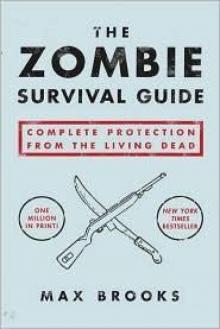 The Zombie Survival Guide: Complete Protection From the Living Dead
The Zombie Survival Guide: Complete Protection From the Living Dead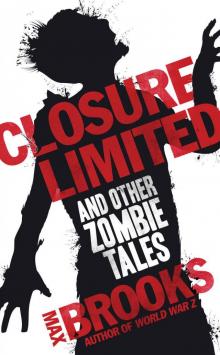 Closure, Limited and Other Zombie Stories
Closure, Limited and Other Zombie Stories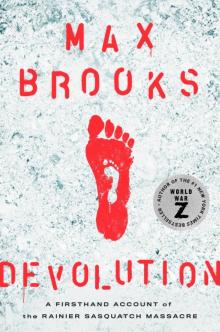 Devolution: A Firsthand Account of the Rainier Sasquatch Massacre
Devolution: A Firsthand Account of the Rainier Sasquatch Massacre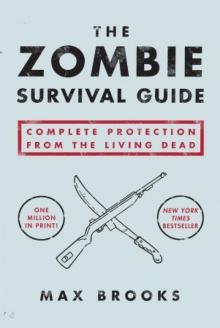 The Zombie Survival Guide
The Zombie Survival Guide World War Z
World War Z Closure, Limited
Closure, Limited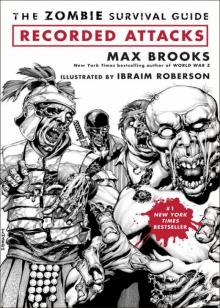 The Zombie Survival Guide: Recorded Attacks
The Zombie Survival Guide: Recorded Attacks World War Z_An Oral History of the Zombie War
World War Z_An Oral History of the Zombie War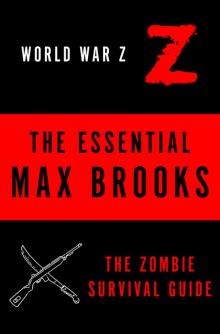 The Essential Max Brooks: The Zombie Survival Guide and World War Z
The Essential Max Brooks: The Zombie Survival Guide and World War Z